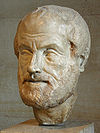- Conimbricenses
-
Part of a series on Aristotelianism  IdeasCorrespondence theory of truth
IdeasCorrespondence theory of truth
hexis
virtue ethics (golden mean)
four causes
telos
phronesis
eudaimonia
arete
temporal finitism
antiperistasis
nature
potentiality and actuality
universals (substantial form)
hylomorphism
mimesis
substances (ousia) and accidents
essence
category of being
magnanimity
sensus communis
rational animal
genus-differentia definitionInfluences and followersPlato
Alexander the Great
Theophrastus
Avicenna
Averroes
Maimonides
St. Thomas Aquinas
Alasdair MacIntyre
Martha NussbaumRelated Philosophy portal
Philosophy portalConimbricenses or Collegium Conimbricenses is the name by which Jesuits of the University of Coimbra in Coimbra, Portugal were known. The Conimbricenses were Jesuits who, from the end of 16th century took over the intellectual leadership of the Roman Catholic world from the Dominicans. Among those Jesuits were Luis de Molina (1535–1600) and Francisco Suárez (1548–1617). In their stricter sense the Coimbra Commentaries, also known simply as Conimbricenses, are mainly a group of eleven books on Aristotle (of which only eight are really commentaries). On the register of the college at various times appeared the names of two hundred Jesuits including professors and students. Toward the end of the sixteenth century and the beginning of the seventeenth, voluminous commentaries on the philosophical writings of Aristotle went forth from the university. These commentaries were dictations to the students by the professors and as such were not intended for publication. Still they were actually published, but fraudulently. In order to interpret and disown incorrect and unauthorized editions, Father Claudius Acquaviva, the General of the Society of Jesus, assigned Father Peter Fonseca, the provincial of the Portuguese province, the task of supervising the revision of these commentaries for publication. Father Fonseca was widely known as the Aristotle of Portugal. The different treatises appeared in the following order:
- Commentarii Collegii Conimbricensis Societatis Jesu in octo libros physicorum Aristotelis Stagyritæ (Coimbra, 1591, reprint Hildesheim, Georg Olms, 1984);
- Commentarii Collegii Conimbricensis Societatis Jesu in quattuor libros physicorum Aristotelis de Cœlo (Coimbra, 1592);
- Commentarii Collegii Conimbricensis Societatis Jesu in libros meteorum Aristotelis Stagyritæ (Coimbra, 1592);
- Commentarii Collegii Conimbricensis Societatis Jesu in libros Aristotelis qui parva naturalia appelantur (Coimbra, 1592);
- Commentarii Collegii Conimbricensis Societatis Jesu in libros Ethicorum Aristotelis ad Nichomachum aliquot Cursus Conimbricensis disputationes in quibus præcipua quaedam Ethicæ disciplinæ capita continentur (Coimbra, 1595);
- Commentarii Collegii Conimbricensis Societatis Jesu in duos libros Aristotelis de generatione et corruptione (Coimbra, 1595, reprint Hildesheim, Georg Olms, 2003);
- Commentarii Collegii Conimbricensis Societatis Jesu in tres libros Aristotelis de Anima (Coimbra, 1592 reprint Hildesheim, Georg Olms, 2006). This treatise was published after the death of Father Emmanuel Golz (whom Father Fonseca had commissioned to publish the earlier volumes by Father Comas Maggalliano (Magalhaens). To it he added a treatise of Father Balthazaar Alvarez De Anima Separata and his own work Tractatio aliquot problematum ad quinque Sensus Spectantium;
- Commentarii Collegii Conimbricensis Societatis Jesu in universam dialecticam nunc primum (ed. Venice, 1606, reprint Hildesheim, Georg Olms, 1976).
To this last treatise was prefixed a forward disowning any connection whatever with the work published at Frankfurt in 1604 and claiming to be the "Commentarii Conimbricenses". The portion of the preface referred to is substantially the following: "Before we could finish the task entrusted to us of editing our Logic, to which we were bound by many promises, certain German publishers fraudulently brought out a work professing to be from us, abounding in errors and inaccuracies which were really their own. They also substituted for our commentaries certain glosses gotten furtively. It is true these writings thirty years previously were the work of one of our professors not indeed intended for publication. They were the fruit of his zeal and he never dreamed they would appear in print."
The last treatise was prepared for printing by Father Sebastian Couto. The entire eight parts formed five quarto volumes, enjoyed a wide circulation, and appeared in many editions, the best known being those of Lyon, Lisbon, and Cologne. The Commentaries are in flowing Latin and are supplemented by reliable explanations of the text and exhaustive discussion of the system of Aristotle. Karl Werner said that the Jesuits of Coimbra gave the world a masterpiece, whose equal is yet to be seen and which has received the admiration it deserves. Father de Backer gives an exact list of all the editions. The later ones have added the Greek text of Aristotle.
 This article incorporates text from a publication now in the public domain: Cassidy, John (1908). "Conimbricenses". In Herbermann, Charles. Catholic Encyclopedia. 4. Robert Appleton Company. http://www.newadvent.org/cathen/04252a.htm.
This article incorporates text from a publication now in the public domain: Cassidy, John (1908). "Conimbricenses". In Herbermann, Charles. Catholic Encyclopedia. 4. Robert Appleton Company. http://www.newadvent.org/cathen/04252a.htm.See also
Original Text
- Original text of In libro de generatione et corruptione, In octo libros physicorum, In libros meteorum, In libro de anima in PDF or JPEG format at University of Coimbra’s site.
Translations
- The Conimbricenses: some questions on signs, Milwaukee: Marquette University Press 2001 (Translation with introduction and notes by John P. Doyle of the commentary to the first chapter of Aristotle's De Interpretatione).
Categories:- 16th-century Latin-language writers
- 17th-century Latin-language writers
- Ethical schools and movements
- Jesuit education
- History of economic thought
- Latin commentators on Aristotle
- Scholasticism
- University of Coimbra
Wikimedia Foundation. 2010.
